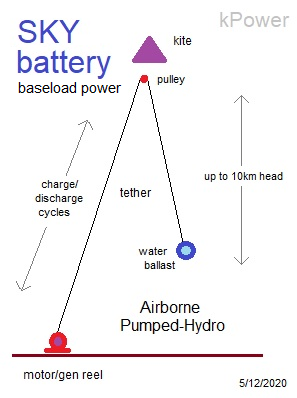[address sky batteries by sailplanes and aircraft in other topics]
Sky Battery Baseload Power (Graphic)

Storage Note- (needs checking) [ ]
10 metric-ton raised 1km = 100 MWsec [ ] ?dimensions???
Pity, the base-10 math will be broken by base-60 Babylonian unit-time to get to 100TWhr, so I may go for just sec and a less conservative storage allowance.
10 hr = 36000 sec
Storage relates to cloud harvesting of water and irrigation by kite, with regen output possible.
10 metric-ton raised 1km = 100 MWsec [ ] ?dimensions???
Pity, the base-10 math will be broken by base-60 Babylonian unit-time to get to 100TWhr, so I may go for just sec and a less conservative storage allowance.
10 hr = 36000 sec
Storage relates to cloud harvesting of water and irrigation by kite, with regen output possible.
Notes:
SkyBattery a complex practice to work out fully. The important thing is to make sure the SkyBattery idea is solidly rooted, because if it is a solution to renewable energy intermittency, that's huge, a key piece of the puzzle. We have planted this idea before, and need to water it.
Consider the graphic just a latest skybattery draft. Will correct and extend. Post drafts in sandbox pages. All content is drafts for improvement. AWEC2020 is a yearlong sandbox, to give high final polish to many themes.
How many kWhr stored in a metric ton of ballast at 10km high?
What is the storage need of the world's grids? My first conservative approximation is ~100TWhr, distributed mostly to high populations in horse latitudes and ITCZ.
Those who have trade winds, sea-breezes, gap-winds, other favorable wind regimes (like winter polar winds), and other storage means, will get by with less skybattery storage.
Multi-power grids can also loft skybattery mass in off hours, by reverse-pumping, to discharge in peak demand cycles.
The pilot-lifter kite is its own subsystem to manage. If it loses wind, the ballast comes down and minimum sink rate is flown.
Tri-tether skybattery versions have enhanced operational capabilities.
I will do small easy skybattery demos by simple unreeling of a descending mass, not all-modes yet. I have a new water lifting rig to fly, but for irrigation and fire-fighting, not high-altitude mass-storage.
A future skybattery may typically separate hoist line from primary anchor line (two-line). A schematic concept may show one line for simplicity. It would work, just not as well.
Dave,
The graphic teases. Much unsaid (for me). Challenging.
I've worked out a cyclic generation that seems to use cycles of locking line in generator while K pulls pulley and thus lifts ballast from ground to altitude while K also goes higher. Then unlock generator while K holds pulley in firm position (will be needing careful gauging of pull during drop-gen) while ballast drops to ground; generation occurs. Then K slacks and lowers while non-generation reeling occurs while water rests on ground. Then lock generator again while K pulls pulley again lifting ballast up again.
Does my description match your intent? Does my description work? Or do you have a careful functioning description that differs? Do you want to confirm showing the graphic only with no detailing of functioning?
We have had lifting mass to give potential energy (PE). And then we drop mass to smash things or load reservoir or put out fires or place things or to advertise or build aerotecture, and other good works.